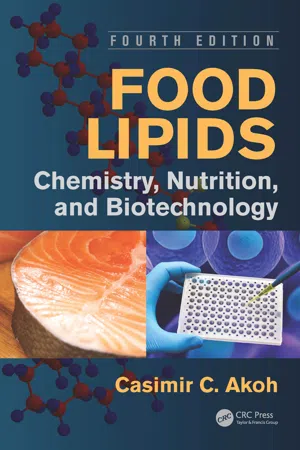
- 1,029 pages
- English
- ePUB (mobile friendly)
- Available on iOS & Android
About this book
Maintaining the high standards that made the previous editions such well-respected and widely used references, Food Lipids: Chemistry, Nutrition, and Biotechnology, Fourth Edition provides a new look at lipid oxidation and highlights recent findings and research. Always representative of the current state of lipid science, this edition provides 16 new chapters and 21 updated chapters, written by leading international experts, that reflect the latest advances in technology and studies of food lipids.New chapters
- Analysis of Fatty Acid Positional Distribution in Triacylglycerol
- Physical Characterization of Fats and Oils
- Processing and Modification Technologies for Edible Oils and Fats
- Crystallization Behavior of Fats: Effect of Processing Conditions
- Enzymatic Purification and Enrichment and Purification of Polyunsaturated Fatty Acids and Conjugated Linoleic Acid Isomers
- Microbial Lipid Production
- Food Applications of Lipids
- Encapsulation Technologies for Lipids
- Rethinking Lipid Oxidation
- Digestion, Absorption and Metabolism of Lipids
- Omega-3 Polyunsaturated Fatty Acids and Health
- Brain Lipids in Health and Disease
- Biotechnologically Enriched Cereals with PUFAs in Ruminant and Chicken Nutrition
- Enzyme-Catalyzed Production of Lipid Based Esters for the Food Industry: Emerging Process and Technology
- Production of Edible Oils Through Metabolic Engineering
- Genetically Engineered Cereals for Production of Polyunsaturated Fatty Acids
The most comprehensive and relevant treatment of food lipids available, this book highlights the role of dietary fats in foods, human health, and disease. Divided into five parts, it begins with the chemistry and properties of food lipids covering nomenclature and classification, extraction and analysis, and chemistry and function. Part II addresses processing and food applications including modification technologies, microbial production of lipids, crystallization behavior, chemical interesterification, purification, and encapsulation technologies. The third part covers oxidation, measurements, and antioxidants. Part IV explores the myriad interactions of lipids in nutrition and health with information on heart disease, obesity, and cancer, with a new chapter dedicated to brain lipids. Part V continues with contributions on biotechnology and biochemistry including a chapter on the metabolic engineering of edible oils.
Frequently asked questions
- Essential is ideal for learners and professionals who enjoy exploring a wide range of subjects. Access the Essential Library with 800,000+ trusted titles and best-sellers across business, personal growth, and the humanities. Includes unlimited reading time and Standard Read Aloud voice.
- Complete: Perfect for advanced learners and researchers needing full, unrestricted access. Unlock 1.4M+ books across hundreds of subjects, including academic and specialized titles. The Complete Plan also includes advanced features like Premium Read Aloud and Research Assistant.
Please note we cannot support devices running on iOS 13 and Android 7 or earlier. Learn more about using the app.
Information
Section I
Chemistry and Properties
1
Nomenclature and Classification of Lipids
CONTENTS
I. DEFINITIONS OF LIPIDS
II. LIPID CLASSIFICATIONS
A. STANDARD IUPAC NOMENCLATURE OF ...
Table of contents
- Cover
- Half Title
- Title Page
- Copyright Page
- Table of Contents
- Preface
- Editor
- Contributors
- Section I: Chemistry and Properties
- Section II: Processing and Food Applications
- Section III: Oxidation and Antioxidants
- Section IV: Nutrition
- Section V: Biotechnology and Biochemistry
- Index